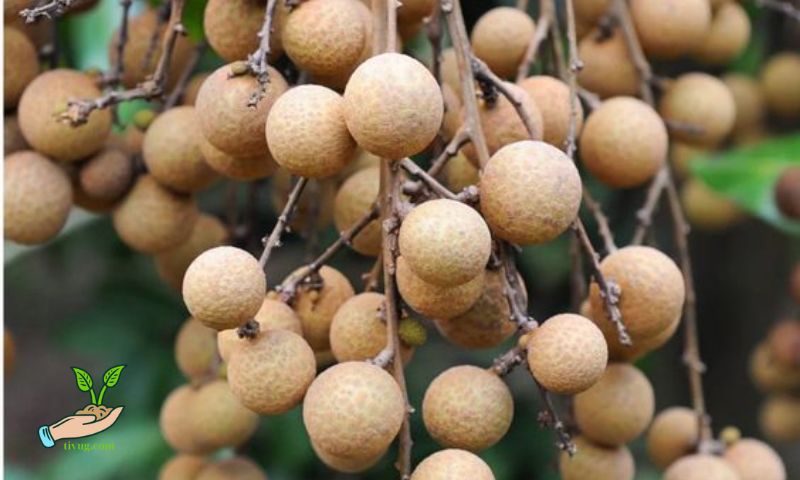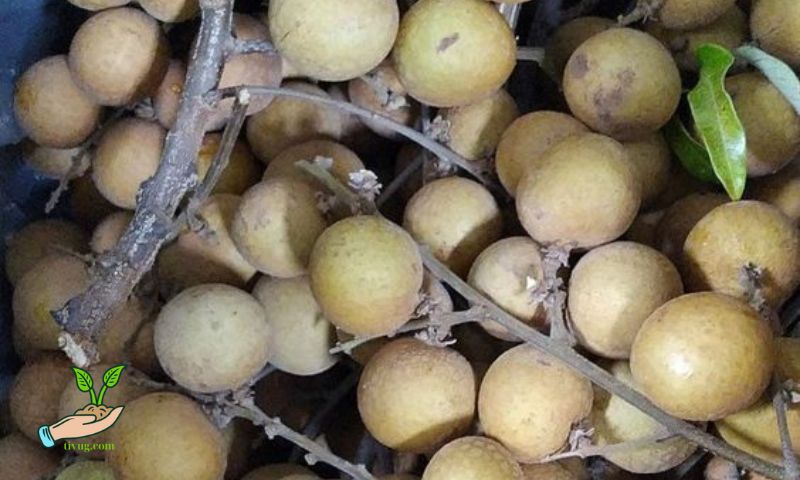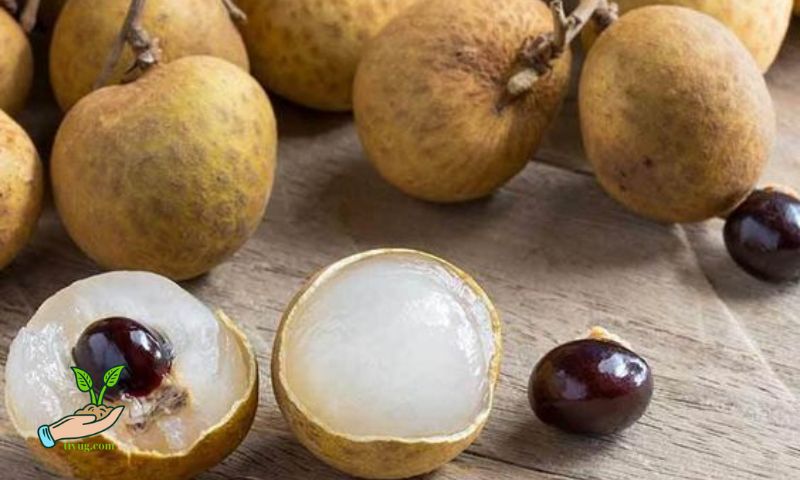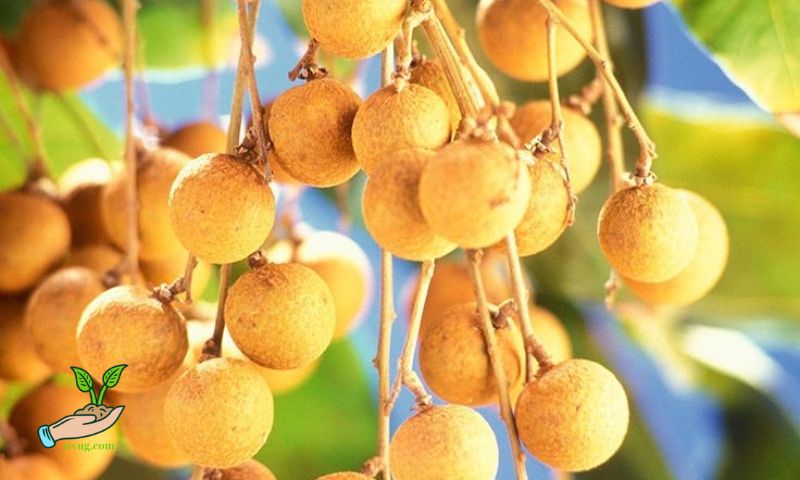The Ido longan variety is a highly regarded type of longan (Dimocarpus longan) known for its exceptional quality and taste. Originating from Southeast Asia, the Ido longan has become a popular fruit in various parts of the world due to its unique characteristics and superior flavor profile. It is a tropical fruit that has been cultivated for centuries, with its cultivation practices refined over time to enhance its yield and quality.
Characteristics of Ido Longan Variety

Physical Description
The Ido longan fruit is notable for its small, round shape, typically ranging from 2 to 3 centimeters in diameter. The outer skin of the fruit is thin and brown, with a slightly rough texture. Once peeled, the translucent, juicy flesh is revealed, surrounding a single, shiny, dark brown seed. The tree itself is medium-sized, with a spreading canopy and dense foliage, making it a suitable choice for both commercial and home orchards. The leaves are glossy, dark green, and pinnate, providing an attractive appearance year-round.
Taste and Nutritional Value
The taste of the Ido longan is often described as sweet and mildly floral, with a hint of muskiness that sets it apart from other longan varieties. The fruit’s texture is firm yet juicy, providing a delightful eating experience. Nutritionally, the Ido longan is a powerhouse, rich in vitamins C and B, potassium, and dietary fiber. It also contains antioxidants and polyphenols, which contribute to its numerous health benefits, including boosting the immune system and promoting healthy skin.
Cultivation and Growing Conditions

Ideal Climate and Soil
The Ido longan thrives in tropical and subtropical climates, where temperatures range between 20°C to 35°C (68°F to 95°F). It prefers regions with distinct dry and wet seasons, as these conditions help induce flowering and fruiting. Well-drained, sandy loam soils with a pH between 5.5 and 6.5 are ideal for its growth. Adequate sunlight is crucial for the tree’s development, so it should be planted in areas with full sun exposure.
Planting and Maintenance
To plant an Ido longan tree, select a healthy sapling and prepare a planting hole that is twice the size of the root ball. Place the sapling in the hole, ensuring that the root ball is level with the ground surface and backfill it with soil. Water the tree thoroughly after planting and apply a layer of mulch to retain moisture and suppress weeds.
Maintaining an Ido longan tree involves regular watering, especially during dry periods, and fertilization to provide essential nutrients. A balanced fertilizer with a ratio of 10-10-10 (N-P-K) is recommended, applied three times a year. Pruning is also essential to shape the tree, remove dead or diseased branches, and promote airflow within the canopy. Proper care and maintenance practices will ensure a healthy, productive tree.
Benefits and Uses
Health Benefits
Consuming Ido longans offers numerous health benefits due to their rich nutrient profile. The high vitamin C content helps strengthen the immune system, fight off infections, and improve skin health by promoting collagen production. The presence of antioxidants and polyphenols helps neutralize free radicals, reducing the risk of chronic diseases such as cancer and heart disease. Additionally, the dietary fiber in longans aids in digestion and supports a healthy gut.
Culinary Uses
Ido longans are versatile fruits that can be enjoyed fresh or used in various culinary applications. They are often eaten as a refreshing snack or added to fruit salads for their sweet flavor and juicy texture. In Asian cuisine, longans are used in desserts such as sweet soups, jellies, and cakes. They can also be dried and used as a natural sweetener in teas and traditional medicines. The unique taste of Ido longans makes them a favorite ingredient in many recipes, both savory and sweet.
Economic Importance

Market Demand
The market demand for Ido longans has been steadily increasing, driven by their superior quality and health benefits. Consumers are becoming more health-conscious, seeking out fruits with high nutritional value, which has boosted the popularity of Ido longans. The fruit’s distinctive flavor and versatility also contribute to its demand in both domestic and international markets. Farmers and producers are capitalizing on this trend, expanding their cultivation areas to meet the growing demand.
Export and Trade
Ido longans have significant export potential, particularly to countries with high demand for exotic fruits. Key markets include the United States, Canada, Europe, and other parts of Asia. The fruit’s long shelf life and ability to withstand transportation make it an excellent candidate for export. Trade opportunities for Ido longans are abundant, and with proper marketing and quality control, producers can achieve substantial economic gains. The global market for longans is expected to continue growing, providing lucrative opportunities for exporters.
Challenges and Solutions
Common Pests and Diseases
Like all fruit trees, the Ido longan is susceptible to various pests and diseases. Common pests include longan stink bugs, fruit borers, and mites, which can damage the fruit and reduce yield. Diseases such as anthracnose, powdery mildew, and root rot can also affect the health of the tree. Integrated pest management (IPM) practices, including regular monitoring, biological controls, and the judicious use of pesticides, are essential to managing these threats. Ensuring proper tree care, such as adequate spacing and pruning, can also help prevent disease outbreaks.
Environmental Challenges
Environmental factors, such as extreme weather conditions and climate change, pose significant challenges to Ido longan cultivation. Droughts, floods, and temperature fluctuations can affect flowering, fruit set, and overall tree health. To mitigate these challenges, farmers can adopt resilient farming practices, such as using drought-resistant rootstocks, implementing efficient irrigation systems, and employing agroforestry techniques to create a more stable microclimate. Research and development of climate-resilient longan varieties are also crucial to ensure the sustainability of longan production.
Conclusion
The Ido longan variety is a highly esteemed fruit known for its unique taste, nutritional benefits, and economic value. With proper cultivation and maintenance practices, it thrives in tropical and subtropical climates, providing a bountiful harvest. The fruit’s health benefits and culinary versatility make it a favorite among consumers, driving market demand and creating significant export opportunities. Despite the challenges posed by pests, diseases, and environmental factors, the Ido longan variety remains a promising crop with a bright future.
As consumer preferences continue to shift towards healthier and more exotic fruits, the Ido longan variety is poised for further growth in popularity. Advances in agricultural research and technology will enhance cultivation practices, making it easier for farmers to grow high-quality Ido longans. With continued efforts in marketing and quality control, the Ido longan variety will undoubtedly secure its place in both local and global markets, benefiting producers and consumers alike.

